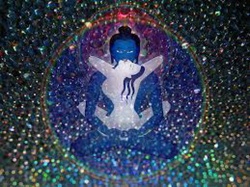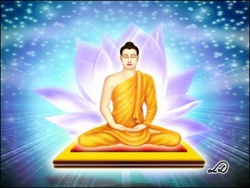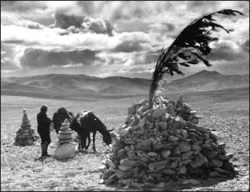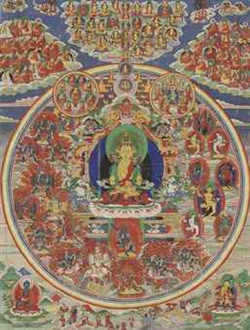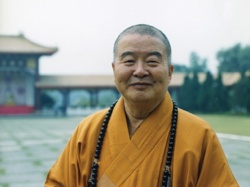Buddhist Epistemology Applied to Learning AT: Essay
By Jeremy Chance
THE SEQUENCE OF COMING TO KNOW AN OBJECT
Buddhist Epistemology Applied to Learning the Alexander Technique
In this essay I will take the Buddhist epistemological 5-fold division of coming to know an object and explore its relation to coming to know the object of natural human co-ordination. The process of discovering this object was the work of F. M. Alexander. It stands in my mind as one of the outstanding discoveries of the 20th century, yet remains largely unrecognized precisely because the knowledge can only be understood in its full impact by a process of direct perception. So I think it is quite interesting to explore how Buddhist epistemology can be understood in an Alexander context.
In this essay I will explore my own knowledge and experience, from my first lesson in 1969, to my experience today as a trainer of Alexander teachers in Japan.
The Epistemological 5-fold division is as follows:
1. Wrong View
2. Doubt: towards wrong view, equivocal, towards correct view
3. Correctly Assuming
4. Inferential Cognition
5. Direct Perception
1. WRONG VIEW
A great debate rages in the Alexander world: how should we advertise ourselves? If we actually say what we do, people just don’t get it. If we talk in the way people expect — just do these things, pay this money, and you will get better—then aren’t we selling ourselves out to the very ideas we are attempting to re-educate?
So every Alexander teacher is usually faced with the same problem when first beginning to guide a new student into knowing their own co-ordination—the student’s profound wrong view of how movement actually works. It is not the kind of ignorance where they are lacking information—that would be easier to remedy—it is the kind of ignorance where they are actively entertaining the wrong idea.
From a very early age, most of us are “told” to stand up straight, to sit well, stop slouching, keep our shoulders back, look sharp, stand to attention etc. etc. The underlying presumption in all these directives is that both parties already know what constitutes good co-ordination. However, even the casual investigator of people’s everyday co-ordination will soon infer that this knowledge is not known. The ubiquitous stiff neck, together with commonly found sore backs and a host of other posturally-induced ailments is adequate testimony of our abyssal lack of real knowledge when it comes to knowing how to best utilize the extraordinarily efficient design of our movement system.
Underlying all our misdirected efforts is an attitude fundamental to all our suffering—attachment to the idea that we need to ‘do’ the correct thing, that there is a ‘correct’ and new object to be found, and when we finally know this object, then all will be well. So we set ourselves off in an endless progression of ‘actions’ to try to ‘correct’ the misaligned and misdirected patterns of movement, and usually find ourselves getting no where. We impose our ideas on the functioning of our system, when the problem is our many erroneous ideas that are already being imposed on the movement of our system.
The essential wrong view here is that we are not an agent in the cause of our problem. Our language is even structured to abrogate our responsibility for our condition. You will hear a person say: ‘I have a bad back’. They have a bad back? Really? What does it look like? Where does it begin and end? How is it that it can function independently of mind to ‘cause’ your problem?
It takes only a short insightful meditation to realize the wrongness of this view, yet this language of cause is universally accepted as a natural way to express of how things are existing in relation to our movements. However, the reality is that nothing, beyond my own actions, is ‘causing’ my neck to be stiff. It is not a result of stress or pressure. It is not a result of ‘people making me do’ things. It is not a result of my being ‘too tired’ or ‘too old’ or ‘too busy’. It is nothing more than my own reaction to whatever cause presents itself. This is familiar territory for a Buddhist—transformation of our state of mind is based on this simple idea. It is a process of changing my reaction to a cause, by recognizing that it is within my power to do so.
2. DOUBT
Student: “I understand what you mean, it’s all because of me. I accept that. So what exercises can I do to make it better?”
Teacher: “There are no exercises.”
S: “What do you mean? How can I practice?”
T: “By becoming aware of what you are doing.”
At this point in the lesson, the student often cocks their head to one side, look suspiciously at the teacher, and wonders if they haven’t wasted their money after all.
Overcoming doubt is a great first problem in the knowing process. And here Alexander evolved an extraordinary solution—he bypassed conceptuality and evolved a means to offer a directly perceived experience of an alternative co-ordination. Direct perception always involves some molecular or particle transaction with phenomena external to our Self, in this case the physical contact of the teachers hands on the various parts of the students body. Through this contact, the teacher is able to impart to the student the experience of a manner of co-ordination more naturally suited to the design of the human structure.
It overcomes doubt very quickly, but it still leaves the student ignorant of how they can bring about this experience on their own. This dichotomy between conceptually knowing and perceptually knowing the experience of good co-ordination is at the heart of widely different teaching pedagogies within the Alexander community.
To know good co-ordination, without having any concept other than the experience, is a wonderful gift to offer any person. In England, the British Medical Journal is about to publish a report on a 10 year, million pound research project into the Alexander Technique and the results, we are assured, are almost beyond belief—it will cause headline news when they are published. I mention this as I believe it constitutes proof that, by directly knowing a thing, we are transformed in ways that knowledge alone can not do.
I have also heard stories of Lamas that can ‘transmit’ some kind of experience to their students which has a transforming effect on their lives. I often wonder what conditions are necessary within the student to be granted such a gift from the Lama? Surely we could all benefit from such a transmission? But that is not the topic of this essay.
Anyway, by far the most effective means of overcoming doubt, is to devise a way that a person can directly experience the fruits of the knowledge that is being imparted. In the absence of being able to do that—what is the choice?
Illustrating Ignorance
To induce knowing without the benefit of experience, it becomes necessary to use logic that can be checked by the person in doubt. In Alexander work, this would include mapping the actual structure of the human body, based a vast body of knowledge that is universally trusted by most people, and comparing that reality with the knowledge that the individual carries around them concerning their own body. The ideas that people can entertain are bizarre—and offering factual knowledge that refutes their current conception is a powerful means of overcoming doubt, or at least nudging it away from the doubt that this is all a lot of new age bunk, to the doubt that maybe there really is something in this…
The same methodology can be applied to everyday movements, comparing a person’s perception of what they are doing, while simultaneously demonstrating—by use or a mirror or video—that the reality does not match their perception of it.
So the work of knowing at this stage involves sweeping away all the clouds of ignorantly held ideas, so there can be a clearing for ushering in new ideas. We could also argue that they are not really new ideas, they were existing all the time. They are like the blue sky which was obscured by the clouds of ignorance. As ignorance is blown away, so is doubt, leaving the clear blue sky and the beginnings of acceptance of how things actually exist, including our way of using ourselves.
3. CORRECTLY ASSUMING
In this phase of knowing Alexander’s work, people often get fanatical—so convinced are they of the efficacy of the work, they want the whole world to know about it. I know, I was one! It is so interesting now to look back and see how my deeply held convictions had no real substance and understanding as understood from my perspective of today.
Correctly assuming a knowledge about co-ordination means that you accept that the information you are being given is correct. Because some of the information is powerful and effective, then all information from teachers is assumed to be correct. This is a grave error. Alexander, and the teachers he directly and indirectly trained, are not possessing knowledge without fault. People can, and do, collect odd ideas and hold these ideas as true.
My intention here is to point out that correctly assumed knowledge, while certainly a step closer to knowing than just having doubt, is still subject to distortion and misapprehension. Often we are taking the information as true on the authority of someone or some group that we respect. We can then regurgitate this knowledge as an ‘authority’ on the subject and become quite convincing in the process, while further distorting it ourselves. So knowledge at this level is unstable, it is subject to distortion and easily lost.
I remember an interesting Zen story that illustrations this stage of ‘knowing’. Many different sects where invited to a ecumenical council to discuss differences of understanding about the cosmological nature of things. In one room were the young monks and priests, all arguing fiercely for their point of view, hungry to prove the other wrong. In another room were the Masters—all silent, quietly knowing the oneness of their common realizations. HH Dalai Lama often talks about his encounter with a meditating priest: how, despite the huge difference in their lineages, he knew at once that the monk had some universal knowledge, common to anyone who has acquired inferential or direct knowledge.
4. INFERENTIAL COGNITION
This is knowledge that you can truly call your own. In my ‘knowing’ of the object of human co-ordination, I can honestly say that I have only, in the last year or two, began to have knowledge that is truly mine. This is after 38 years of studying the subject. By reflecting on how I know this information, I can glimpse the meaning of what it means to know an object through inferential processes.
In my own case, the zeal emptied out of my work, and it become more relaxed and enjoyable. Not that I became quiet, but my inner need to prove others wrong—and convince myself I was right—which was so apparent in the earlier stage of knowing, ceased to be of so much concern to me. I was far more interested in understanding the condition of the other person’s knowing—seeing much more of what is around me, because my inner world became quieter.
I think a relaxed attitude results because the knowledge is truly ‘seen’ as it manifests in the world. It certainly results in a transformation of behaviour in Alexander terms, and I imagine this must also be true of Buddhist practise.
5. DIRECT PERCEPTION
In the Alexander world, this knowledge is imparted through the teacher’s hands right at the beginning of the process. But it is experience without knowledge backing it. It is as though someone has helped you walk through a door, but when you arrive on the other side—there is nothing there! Everything is empty. It is like experiencing the reflection of the moon in the lake—it is not the real thing, but it is close enough to convince us that something special is happening, that you think you know what the moon is really like.
In Alexander’s own case, this was not the case. Alexander could only come to the experience of knowing the object of natural human co-ordination by a long, rigorous process of observation, analysis and experimentation. He has written about this period of discovery, and it is interesting to note that his final obstacle, that for several years blocked his ability to know, was that the experience was so startling and unexpected that his system simply refused to be guided by the knowledge contained within that experience.
Later Alexander said: “We can’t do what we don’t know, if we keep on doing what we do know.” The power of directly knowing an object is that it completely blows away any apprehension that preceded it. (At least—I imagine it is that way.) And yet, before the door can be opened to that new experience, we have to be guided by a 100% trust in our own reasoning processes. We must be convinced, without a shred of doubt, about the conceptual construction we have built from our long hours of listening, reflecting and meditating. So direct perception of an object, Dharakirti surmised, must be built upon a rock solid base of inferential cognition.
There is a lot more I could add, but I am already overdone! Thanks for your patience in seeing it through to the end.
Kyoto, April, 2007


